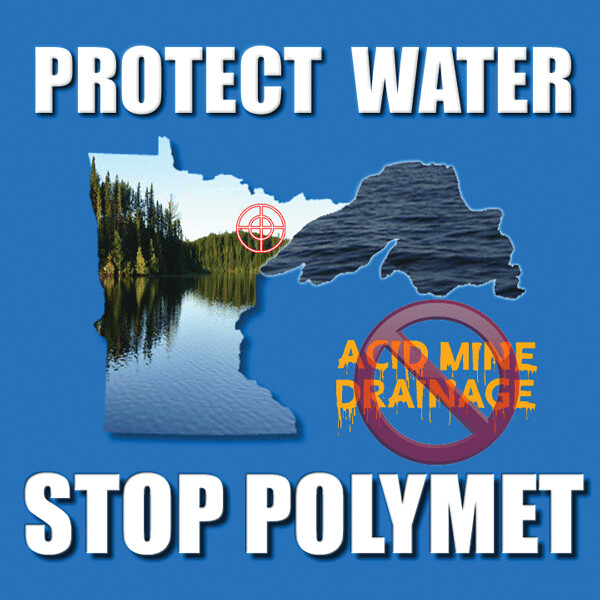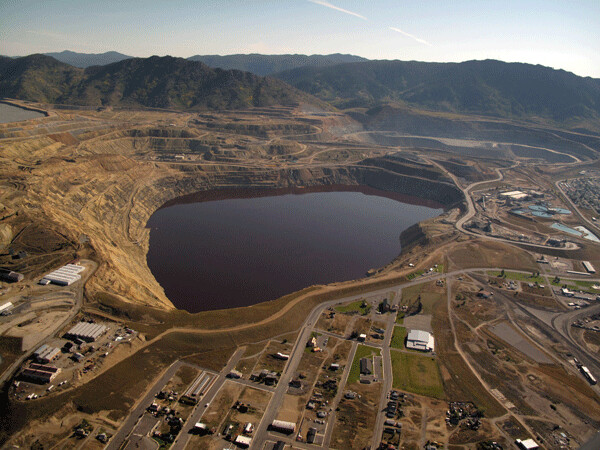The Permit to Mine: PolyMet’s Path to Perpetual Pollution

U.S. and Minnesota citizens are facing a critical moment in our state’s history. Governor Mark Dayton has been swayed by Iron Range politicians and mining interests to support the permitting of PolyMet, what would be the first ever copper-nickel sulfide mine in our state. On October 23, 2017 he told the St. Paul Press that he’s moved from being “genuinely undecided” on the proposed PolyMet copper-nickel mine to being a genuine supporter of the project. He also noted, “Nothing of [this] magnitude is risk free... but I think it’s a risk worth taking and I support the project.” However the Governor didn’t state who would be on the receiving end of the risk.
The receiving end would be us--anyone living in the St. Louis River watershed of northeast Minnesota, including rural areas, Cloquet, Fond du Lac, and Duluth. And all residents and citizens who recreate, fish, hunt, or own property in Minnesota’s Arrowhead--as a 6,500 acre tract of public Superior National Forest land, consisting of high quality wetlands, forests, and habitat, would be traded to PolyMet for their open pit sulfide mine. Additional acreage is destined to be impacted by mine activities and mine expansion, as adjoining sulfide deposits are on the radar screen--ready to turn the Arrowhead region into a toxic, polluting industrial sulfide mining zone.
Those who want sulfide mining jobs so that they can continue to experience and enjoy the north woods are deluding themselves.
Selling us down the river
PolyMet is only the first in line. Multinational corporations, including Teck Resources, Encampment, Rio Tinto, and Twin Metals are waiting in the wings, ready to create a sulfide mine industrial zone in Minnesota’s most vulnerable and valuable headwaters. If permitted, PolyMet would open the door to a toxic and destructive copper-nickel sulfide mining district in the heart of the Superior National Forest. Sulfide mining would leave behind a polluted and denuded landscape, with a massive loss of wetlands, harm to wildlife, and water pollution lasting for at least five centuries. Exploration for copper-nickel and other metals is advancing through all of northeastern Minnesota, from the Boundary Waters to Lake Superior, and south to Carlton and Aitkin counties and along the Mississippi River.
According to Minnesota Environmental Partnership polls taken in February of 2017, 74% of Minnesotans oppose PolyMet’s toxic sulfide mine that would be located on the headwaters of Lake Superior (https.//www.mepartnership.org/safe-mining/). Yet current political strategy is pushing the permit to mine process out ahead of the 2018 elections, seeking to drown out the controversy over sulfide mining, burying the real science, defying common sense and logic.
Representative Rick Nolan has gone so far as to introduce a bill, H.R. 3115, the Superior National Forest Land Exchange Act of 2017, which would bypass citizen due process and compel the U.S. Forest Service to trade public land to PolyMet for its open pit mine. The bill passed the U.S. House and now sits in the Senate Agriculture, Nutrition, and Forestry Committee, of which Senators Amy Klobuchar and Tina Smith are members. A foreign mining corporation is deemed more important than U.S. citizens’ rights.
In the meantime, Tom Landwehr, the politically appointed commissioner of the Minnesota Department of Natural Resources (DNR), has followed Governor Dayton’s lead to get PolyMet permitted.
Permit to Mine public meetings and comment period slated
The DNR is holding two public meetings on the PolyMet permit to mine, to allow for public comment. As of this writing, the DNR has not indicated the exact procedure at the meetings, only that oral and written comments will be accepted at the time.
Comments can also be submitted through the state’s PolyMet Portal (http://polymet.mn.gov/). Comments on the project will be accepted through March 6, 2018. However, if choosing to submit online, allow yourself ample time to work your way through the portal. DNR Commissioner Tom Landwehr has refused a request by local citizens (those most likely to be impacted by the mine) and environmental groups to provide the use of the usual email address method for submitting comments.
At the same time that comments are being solicited by the DNR on the permit to mine, the Minnesota Pollution Control Agency has issued a draft air permit, draft water quality permit, and draft 401 certification (water discharge permit) on the PolyMet/NorthMet project. Comments on these permits will be accepted at the same two public meetings.
It’s quite obvious that the public will have little time to comprehend and comment on the large amount of material included with the multiple state permit applications for PolyMet’s mine.

What do we already know?
The PolyMet Environmental Impact Statement (EIS) has already given us some basic answers. PolyMet, once permitted, will leave behind a minimum 500 year legacy of water pollution. Toxic heavy metals and acid mine drainage will leach from waste rock piles, open pits, and tailings virtually forever. The old LTV taconite tailings basin that PolyMet is proposing to re-use is already unstable, presenting the risk of catastrophic dam failure. Proposed copper-nickel hardrock mining would begin with the removal of trees, soil, wetlands, and wildlife habitat. Open pit operations would include blasting of bedrock with toxic blasting agents, hauling, crushing and grinding on a 24 hour basis. A proposed hydrometallurgical plant would use chemicals and heat to leach out metals, leaving toxic residues behind. Waste rock piles would dwarf those of taconite mines, as low-grade copper-nickel sulfide mining would result in 99% mine waste.
Minnesota’s water rich environment is particularly susceptible to acid mine drainage and heavy metal leaching, as sulfur needs both air and oxygen to become acidic (H2SO4). Sulfates as a by-product of mine operations will allow for more methylation of mercury, which is released from existing taconite and coal burning plants. Natural wild rice stands will be threatened or destroyed. The sole drinking water aquifer of the area will be depleted by mine withdrawal, and contaminated and degraded. People’s health will be put at risk from exposure to toxic heavy metals leached into the water or released into the air and onto the land from sulfide mining.
So who benefits?
While blue collar working jobs have value in our society, they should not be jobs that put people’s health and wellbeing at risk. Those impacted from sulfide mine pollution would include children, mothers, and future generations.
The mining controversy has been politically messaged as “us against them,” the hardworking miners against outsiders. This political message has helped turn the Iron Range from being traditionally blue, to purple. To hang on to their power, the Democratic Iron Range politicians believe that they must get PolyMet permitted, regardless of the price. Political power and immediate election results outweigh future costs and risk to those living downstream of the toxic sulfide mining being proposed.
Mining interests have spent the entire PolyMet process promoting mining, and promoting and exploiting our use of metals in order to guilt us into giving multinational mining companies a social license to mine. Mining interests are trying to convince us that we must destroy the world in order to save it.
Just say No
The Minnesota DNR (Lands and Minerals Division) has never denied a permit to mine, nor has a mine ever been shut down for failure to meet environmental standards or conditions. We cannot continue to be at the mercy of an agency that is politically controlled and has the dual mission of both promoting and regulating mining.
This is our opportunity to respond in opposition to a lasting legacy of toxic mining, the destruction of our public lands and wildlife habitat, the pollution of our waters, and the threats to our health and that of the generations to follow. In other words, the destruction of all that we value as a reason for living here.
Citizens are allowed to submit more than one comment — as there are many parts to the draft documents. If you can’t attend a public meeting, check out Save Our Sky Blue Waters (www.sosbluewaters.org) website for more information. Oppose turning Superior National Forest into a superfund site.
Protect Water, Stop PolyMet
Public meeting schedule:
Wednesday, February 7, 2018
Mesabi East High School
601 N 1st St W, Aurora, MN 55705
4:00-9:00 p.m. open house
6:00-9:00 p.m. public comment forum
Thursday, February 8, 2018
Duluth Entertainment Convention Center (DECC)
350 Harbor Drive, Duluth, MN 55802
1:00-9:00 p.m. open house
6:00-9:00 p.m. public comment forum
In case of weather related cancellation, alternative dates are February 21 and 22.
Address for mailing comments:
MN Department of
Natural Resources
Division of Lands and Minerals
500 Lafayette Road N, Box 45
St. Paul, MN 55155-4045
